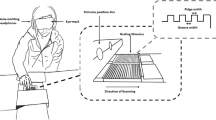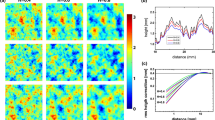Abstract.
The present experiments were designed to determine the ability of humans to estimate the roughness of raised dot surfaces using passive touch (subject immobile, surfaces scanned proximo-distally under the tip of the middle digit). In two initial experiments, the spatial period in the direction of the scan (longitudinal SP) was varied from 1.5 to 5 mm, while the transverse SP was kept constant at 2 mm. These surfaces were identical to those used in single unit recording experiments in primates which have shown that neurones in primary somatosensory cortex (SI) show graded changes in discharge over the same range of SPs. In the third and fourth experiments, roughness perception was studied over an extended range of longitudinal SPs (1.5–8.5 mm); transverse SP was either 1 or 2 mm. We also examined the effects on roughness perception of presenting the surfaces at two different scanning speeds (~50 and ~95 mm/s), similar to those employed in the unit recordings. Magnitude estimates of perceived roughness increased in a nearly linear fashion as longitudinal SP was increased up to either 5 mm (experiments 1 and 2) or 8.5 mm (experiments 3 and 4). A modest increase in the transverse SP elicited a small increase in roughness estimates, with preservation of the linear relation between roughness and longitudinal SP. The roughness sensation evoked by each surface was not affected by the change of the temporal pattern of scanning (Low and High speeds). These results showed that there is perceptual constancy for roughness across a twofold change in passive scanning speed, and that roughness is a function of the spatial characteristics of these raised dot surfaces. While a spatial code may underlie this observation, it is suggested that a simpler intensive code may be sufficient to explain the psychophysical observations. Based on the results of neurophysiological recordings in SI cortex, it is suggested that an invariant central representation of surface roughness could be extracted from the ambiguous peripheral signals that covary with roughness and the stimulating conditions (e.g. speed) by means of a simple subtraction process.
Similar content being viewed by others
Author information
Authors and Affiliations
Additional information
Electronic Publication
Rights and permissions
About this article
Cite this article
Meftah, E., Belingard, L. & Chapman, C. Relative effects of the spatial and temporal characteristics of scanned surfaces on human perception of tactile roughness using passive touch. Exp Brain Res 132, 351–361 (2000). https://doi.org/10.1007/s002210000348
Received:
Accepted:
Published:
Issue Date:
DOI: https://doi.org/10.1007/s002210000348




